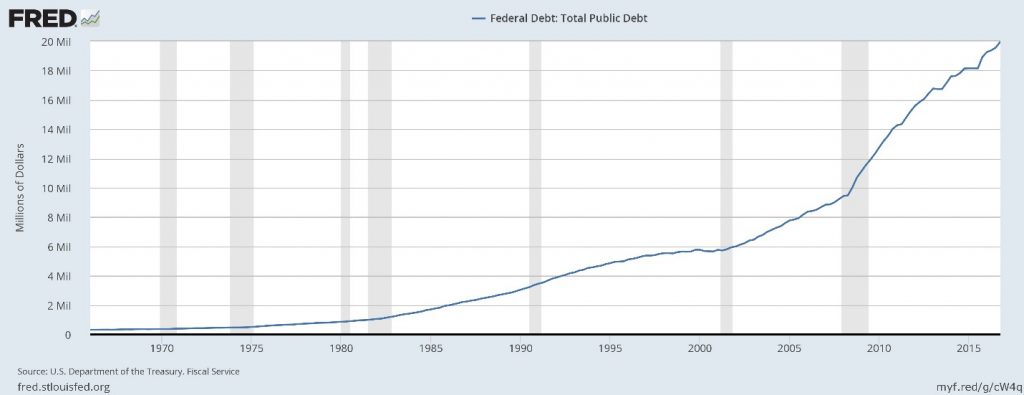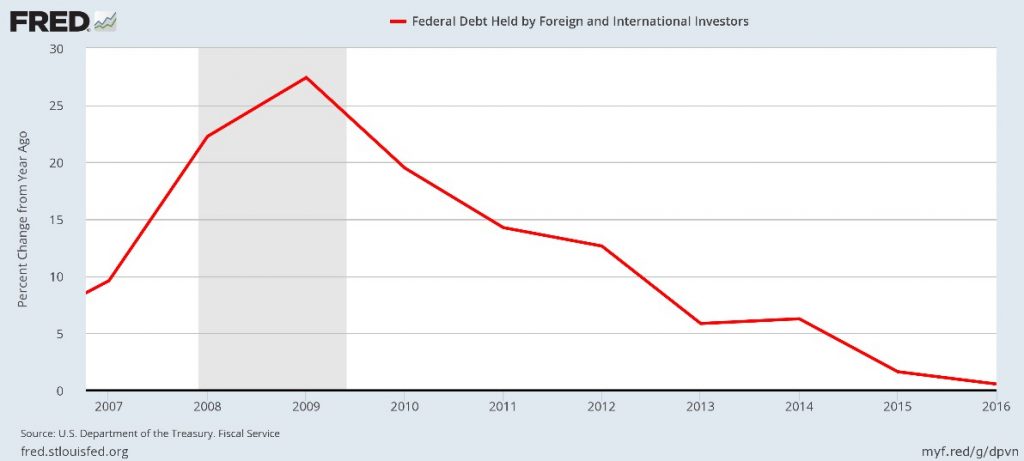There are two big problems facing the United States today that are getting very little media attention. The first has to do with the ballooning national debt; it has no end in sight. The second is the abandonment of funding of the U.S. debt by foreigners. Rising debt under an environment in which foreigners no longer want to buy that debt is a scary predicament for our country.
Let’s start with the national debt. It’s around $20.0 trillion now—more than our gross domestic product (GDP)—with no end in sight for this great big hole!
The government is spending without remorse, but few seem to care. The trajectory of the federal debt as depicted in the chart below is like a straight line up since the 2000s.
And it’s getting worse. In the government’s most recent fiscal year, on October 1, 2016, the U.S. government already incurred a budget deficit of $348.98 billion, and we are only halfway through the government’s fiscal year! (Source: “Monthly Treasury Statement,” Bureau of the Fiscal Service, last accessed April 19, 2017.)
According to the Congressional Budget Office (CBO), a nonpartisan agency, the U.S. government is now projected to report annual budget deficits until the year 2047! And the CBO’s forecasts do not include natural disasters, severe recession, economic crises, or war. (Source: “The 2017 Long-Term Budget Outlook,” Congressional Budget Office, last accessed April 19, 2017.)

(Source: “Federal Debt: Total Public Debt,” Federal Reserve Bank of St. Louis, last accessed April 19, 2017.)
Now, let’s move to who’s funding our debt. In the not-too-distant past, the Japanese and the Chinese were big buyers of U.S. bonds used to fund the U.S. national debt. But, in recent years, foreign buyers of our debt have disappeared.
The chart below gives credence to the old adage “a picture is worth a thousand words.” The chart shows the year-over-year percentage change in the amount of the U.S. national debt held by foreign and international investors. The gray-shaded area on the chart represents the Great Recession of 2007–2009.

(Source: “Federal Debt Held by Foreign and International Investors,” Federal Reserve Bank of St. Louis, last accessed April 19, 2017.)
The above chart is alarming, for sure. And it’s something you won’t hear or see during the evening news; foreign and international investors have lost their appetite for U.S. debt. Since the Great Recession, as our U.S. national debt soared, foreign buyers of that debt fled.
So, who is buying the bonds that the U.S. so desperately needs to fund its debt? American investors? The Federal Reserve? Your guess is as good as mine, but I doubt we’ll ever know the truth as to who is funding our debt these days.
Dear reader; one thing is certain. The more debt we pile on, the less our dollar will be worth. That’s why I have been pushing gold and silver for years now.






